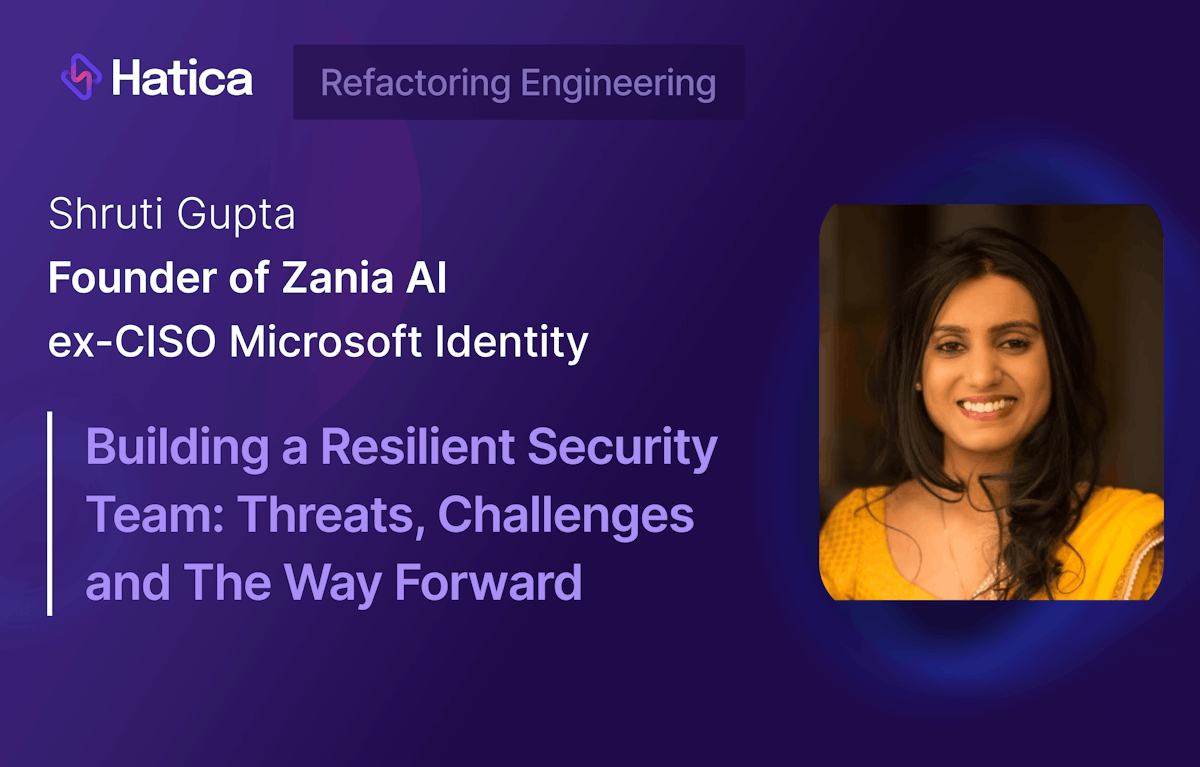Shruti Gupta, the CEO and Founder of Zania.AI brings a wealth of experience from her time at Microsoft Identity. There, she led the AI-driven revolution for Identity Security and Privacy, protecting one of the world’s largest and most targeted systems.
She has applied all her learnings at Zania.AI, which is leading the way in using artificial intelligence to enhance identity security and privacy. The company creates advanced AI solutions to protect digital identities, prevent cyber threats, and ensure user privacy.
In a recent conversation, Naomi Chopra, our Founder & CEO at Hatica, spoke with Shruti. Together, they explored the nuances of leading security teams and how to navigate through the growing complexities of it. Shruti shared her unique experiences and insights with Naomi during their candid discussion.
In this edition of Refactoring Engineering, we explore Shruti's engineering vision, the day-to-day differences between the life of a security engineer and a software engineer, and her biggest challenges as the head of a security engineering team.
Understanding the Life of a Security Engineer
How does the day-to-day life of a Security Engineer differ from that of a Core Software Engineer?
Security engineer’s daily life centers around protecting and fortifying systems against potential threats. This involves continuous monitoring, threat assessment, and incident response. They focus on identifying vulnerabilities, implementing security measures, and ensuring compliance with security standards. In contrast, a core software engineer is primarily concerned with designing, developing, and optimizing software applications. While security is a consideration, their primary focus is on functionality, performance, and the overall user experience.
Security engineers operate in both proactive and reactive modes, always anticipating and responding to threats, whereas software engineers follow a more predictable development cycle.
Balancing Security and Productivity
What is your biggest challenge as the head of a security engineering team?
One of the biggest challenges is balancing the need for robust security with the operational efficiency and innovation of the organization. Security measures can sometimes be perceived as obstacles to productivity, so it’s crucial to implement them in a way that minimally disrupts the workflow. Additionally, keeping the team updated with the latest security threats and technologies, managing limited resources, and fostering a culture of security awareness across the organization are some of the continuous challenges.
The 'Paranoia Moment' in Security
What is the ‘paranoia moment’ for someone leading a security engineering team?
The ‘paranoia moment’ often occurs when a new vulnerability is disclosed publicly, especially if it impacts widely-used software or hardware. I recall when the Spectre and Meltdown vulnerabilities were revealed. These hardware vulnerabilities affected almost every modern processor, leading to widespread concern. My team had to quickly assess the impact, develop mitigation strategies, and communicate with stakeholders, all while ensuring that their systems remained secure and operational. The uncertainty and potential for exploitation during such moments is a stark reminder of the ever-present threat landscape.
Overcoming Barriers to Building Effective Security Systems
What are the most common factors that prevent security engineering teams from doing their best work?
Several factors can get in the way of security engineering teams doing their best work, such as the growing complexity of systems, organizational silos, and resistance to change.
Resource Constraints
With a limited budget and not enough people, it can be tough to put comprehensive security measures in place. Security teams often struggle with inadequate funding, which affects their ability to acquire the latest tools and technologies.
Evolving Threat Landscape
The rapid evolution of threats means teams have to keep learning and adapting constantly, which can be a real challenge. Cyber threats are becoming more sophisticated and frequent, requiring security engineers to stay up-to-date with the latest trends and attack vectors.
Growing Complexity of Systems
Modern IT environments are incredibly complex, and finding a way to secure them without affecting performance is no easy task. As organizations adopt more advanced technologies and integrate various systems, the attack surface expands. Security teams must navigate this complexity to protect data and infrastructure effectively.
Organizational Silos
When departments don’t communicate and collaborate effectively, it can lead to security oversights. Security is not just the responsibility of the IT department; it needs to be a collaborative effort across the entire organization. However, when departments work in isolation, critical security information and best practices can be missed.
Resistance to Change
Introducing new security protocols can sometimes be met with resistance from other teams, especially if they see these changes as obstacles to their work. Employees might view new security measures as cumbersome or unnecessary, leading to pushback.
Leveraging Generative AI in Security
How can Gen AI enable security engineering teams to improve the security of the systems?
Generative AI can significantly enhance the capabilities of security engineering teams. By handling threat detection, response, automation, and more. AI can make a substantial impact on the security landscape. She goes on to explain these benefits in more detail.
Threat Detection and Response
Generative AI can analyze vast amounts of data to identify unusual patterns and potential threats in real time. Traditional methods often struggle with the sheer volume and complexity of data, but AI can sift through this information quickly and efficiently.
Automation
Automating routine security tasks allows teams to focus on more complex issues. Many security processes, such as log analysis and system monitoring, are repetitive and time-consuming.
Vulnerability Management
AI can help in predicting and identifying vulnerabilities more effectively. By continuously scanning systems and applications, AI can detect weaknesses that might be overlooked by manual inspections. It can also prioritize these vulnerabilities based on their potential impact, enabling security teams to address the most critical issues first.
Incident Response
AI-driven systems can provide recommendations and automated responses to incidents, reducing response time. When a security breach occurs, every second counts. AI can quickly analyze the situation, suggest appropriate actions, and even execute some of these actions automatically.
Continuous Learning
AI systems can adapt to new threats more quickly than traditional methods. Cyber threats are constantly evolving, with attackers developing new techniques to bypass security measures.
The Essential Security Tool Stack
Which tools do you use while guarding the engineering environment? In other words, what does your tool stack look like?
Our tool stack includes a variety of advanced security solutions:
- Endpoint Detection and Response (EDR) Tools: For real-time monitoring and response.
- Security Information and Event Management (SIEM) Systems: For aggregating and analyzing security data.
- Intrusion Detection and Prevention Systems (IDPS): To detect and prevent potential threats.
- Vulnerability Scanners: To identify and manage vulnerabilities.
- Firewalls and Next-Generation Firewalls (NGFWs): For network security.
- Encryption Tools: To protect data at rest and in transit.
- Identity and Access Management (IAM) Solutions: To control access to resources.
- AI and Machine Learning Tools: For advanced threat detection and response.
Expectations and Realities of Security Leadership
What expectations does the organization have from a security engineering team and its leader?
The organization expects the security engineering team to:
- Protect Assets: Ensure the confidentiality, integrity, and availability of data and systems.
- Compliance: Maintain compliance with industry standards and regulations.
- Incident Response: Quickly detect and respond to security incidents.
- Risk Management: Identify and mitigate security risks.
- Innovation: Continuously improve security measures and stay ahead of emerging threats.
As a leader, the expectations include setting a clear security strategy, fostering a culture of security, ensuring team development, and effective communication with stakeholders.
The Thrill and Challenges of Security Work
Considering they call it “security teams,” on a scale of 1-10, is your job that scary?
On a scale of 1-10, I would rate it around 7. While the constant vigilance and responsibility can be daunting, it is also immensely rewarding to know that we are protecting critical assets and data. The key is to stay prepared, be proactive, and continually improve our defenses.
Some Essential Tips for Budding Security Managers
Which tools do you use while guarding the engineering environment? In other words, what does your tool stack look like?
- Foster a Collaborative Culture: Encourage open communication and collaboration within the team and across the organization.
- Continuous Learning: Invest in training and development to keep the team updated with the latest security trends and technologies.
- Prioritize Tasks: Focus on the most critical security risks and address them first.
- Leverage Automation: Use automation to handle routine tasks and free up time for more strategic activities.
- Engage with the Community: Participate in security communities and forums to stay informed and share knowledge.
- Promote a Security-First Mindset: Ensure that security is considered in every aspect of the organization's operations.
About Refactoring Engineering
Refactoring Engineering is an initiative by Hatica that unites product innovators, engineering leaders, and thought leaders from the engineering community. This platform is dedicated to sharing experiences and insights on managing and leading engineering organizations in today's fast-paced tech world.
If you know a leader who would be a great fit, please nominate them by emailing eac@hatica.io with their details and why you think they should be part of Refactoring Engineering. Your nomination will help us include more diverse and impactful voices in our community.



